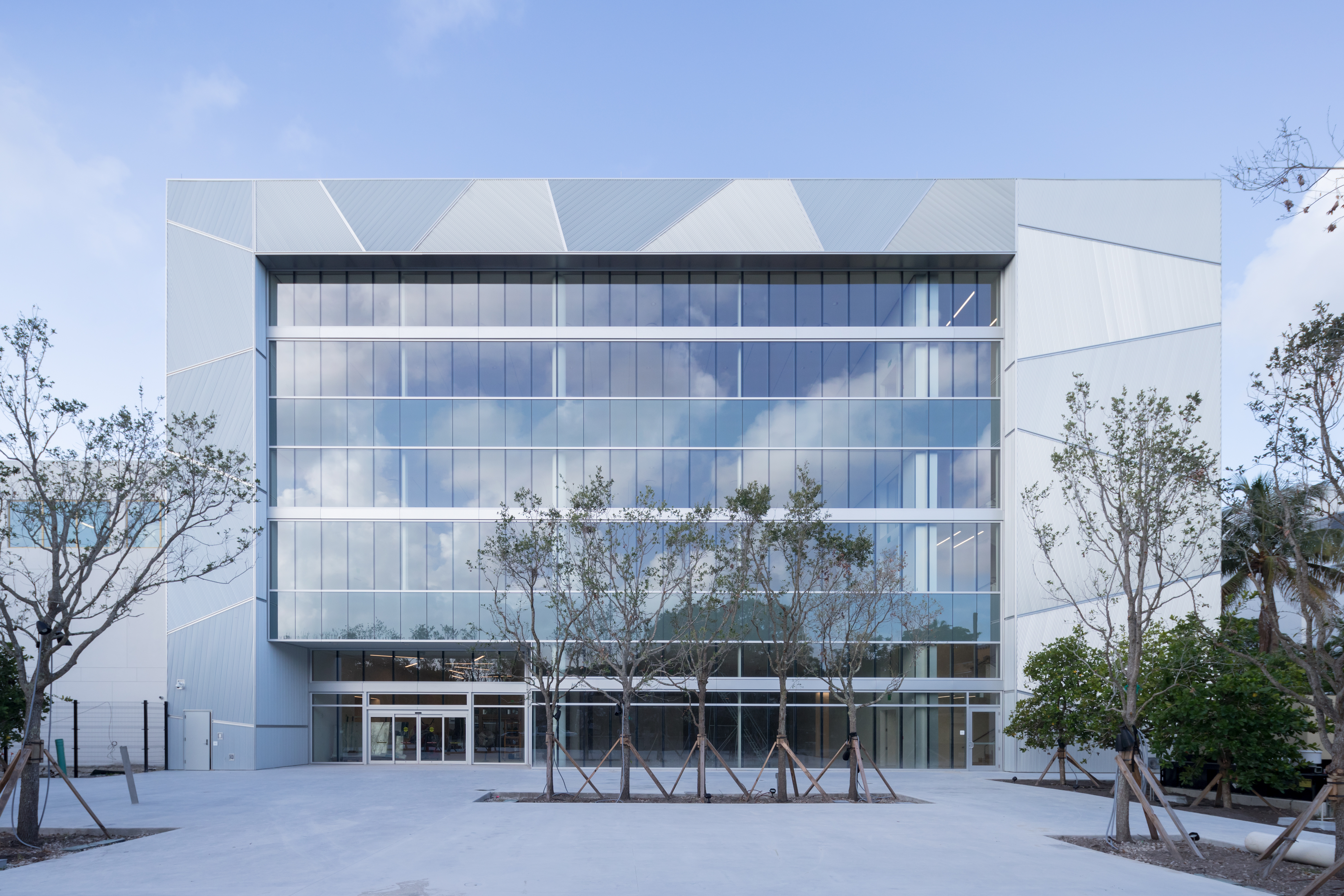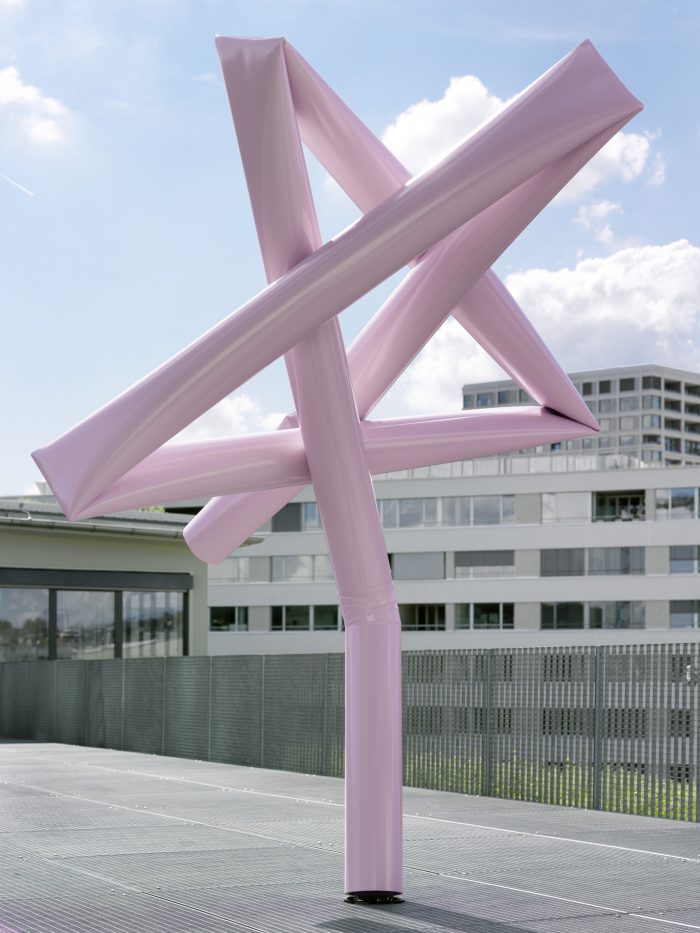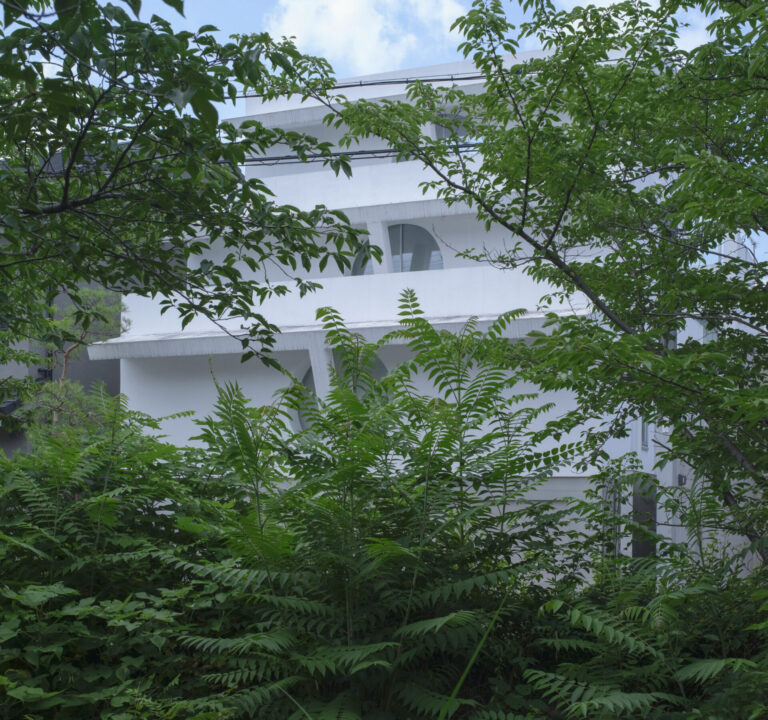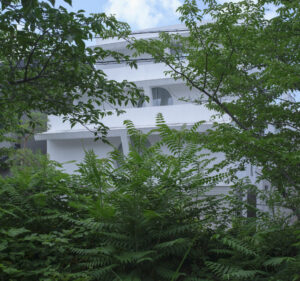
Six weeks before the opening of the Institute of Contemporary Art Miami’s permanent home in the Design District, the museum’s dazzling new building heralded the organization’s next chapter. I met ICA Miami director Ellen Salpeter on a mid-October afternoon outside the jewel-like façade, on 41st Street in the Design District. The pattern of interlocking geometric planes with embedded lights, a showstopping detail in the construction by the Spanish firm Aranguren + Gallegos Arquitectos, glinted in the bright sun. Construction crews hammered away at a parking lot across the street.
The director led me inside for a tour of the museum, where art preparers were beginning to install the inaugural exhibitions. The building opens its doors on December 1, a week before international crowds flock to Miami for Art Basel. Salpeter, who joined the ICA Miami at the end of 2015 as its first permanent director, exuded a decisive focus that belied just how young the institution was. The ICA Miami was formed in 2014, when former board members of the Museum of Contemporary Art North Miami broke away from their municipal landlords. Alex Gartenfeld, former interim director at MOCA North Miami, was hired as deputy director and chief curator of the fledgling institution. In December 2014, the museum began programming exhibitions in the historic Moore Building; the space was provided rent-free from Miami Design District developer Craig Robins, founder and CEO of Dacra Development.
The new, three-story ICA Miami is located just a few blocks away from the landmark Moore Building, but its look and feel lend gravitas to the museum. The airy, modern construction boasts 20,000 square feet of gallery space, with a 15,000-square-foot sculpture garden. Construction of both was singlehandedly funded by a generous private donation, courtesy of auto magnate Norman Braman and his wife Irma Braman. “It’s everything we dreamed of, and more,” said Irma Braman, who is co-chair of the ICA Miami’s board. She strolled through the galleries with her fellow co-chair Ray Ellen Yarkin, stopping to admire luminous abstract paintings by the Haitian-born artist Tomm El-Saieh in the ground-floor project space. Salpeter noted that Bramans’ generosity not only allowed for the new building, but for the ICA Miami to remain free of charge for all visitors.
The museum’s new home also comes courtesy of Robins, whose Miami Design District Associates donated the land for the venture. “When I had the opportunity to support and collaborate with Norman Braman, I could not have felt more inspired,” the developer said. Reflecting on the new building, he added, “I think that this is a magical moment for Miami. We’re really becoming a more mature city. While we will remain a city of the future, we’re also beginning to establish important institutions and that’s going to be a legacy of our time.” Robins highlights the ICA Miami as part of a great expansion of the design district, including a public sculpture program in collaboration with the museum.

Salpeter describes the ICA Miami as a “museum of firsts,” from the architecture to the exhibition program. The new building is the first U.S. construction by Aranguren + Gallegos. The sculpture garden, conceived by Project Space/Jonathan Caplan in association with the South Florida–based landscape architect Fernando Wong, is Wong’s first sculpture garden commission. Wong explained that his priorities were to “open up and elongate vistas, to give dynamic movement to a rectangular space,” through planes that reveal and filter views through vegetation. The garden has been designed to integrate with the existing tree canopy of the neighbor- hood, including species native to South Florida. The third floor’s glass windows open up to an expansive view of the residential neighborhood immediately north of the ICA Miami.
The sculpture garden features commissions by Miami-based artist Mark Handforth, New York–based artist Abigail DeVille, and the Puerto Rico-based duo Allora & Calzadilla, who represented the United States in the 2011 Venice Biennale, as well as a Pedro Reyes sculpture purchased by the museum. The installation is capped by a long-term loan of a George Segal sculpture from 1979, from Martin Z. Margulies, a seasoned collector who presents exhibitions from his collection in a Wynwood warehouse space. Margulies expressed his enthusiasm in seeing visitors interact with Segal’s work, Three Figures and Four Benches, during the ICA’s gala in early October. “I was a good friend of George, and he would have been so happy to see people sitting there with those sculptures,” he said. “It was almost a surreal experience.”
As Salpeter clarifies, the museum’s mission is to show artists new to Miami audiences, and to shed scholarly light on previously lesser known aspects of artists’ practices. “With the expanded gallery space, we are able to create intergenerational dialogues,” she added. The ground floor will be devoted to single-artist presentations from the 1960s to today. Left of the entrance, a gallery features a suite of 22 gritty black-and-white photographs by artist Robert Gober, taken between 1978 and 2000, on long-term loan from the Bramans. The photographs are accompanied by one of the artist’s chilling, untitled drain pieces, created in 1993-4, built into the floor with running water. “Gober is one of the most important living artists today,” she said. “Having one of his seminal installations in Miami is critically important for audiences here.
Next to Gober’s work, visitors will encounter a gallery featuring Soup Course at the She-She Café, 1982, an installation by the artists Nancy Reddin Kienholz and Edward Kienholz. The eerie sculptural tableau, from the ICA Miami collection, depicts a couple and a young woman dining separately in a restaurant. According to the museum’s website, “The work suggests that patriarchal aggression and sexuality are at the center of conventional American narratives.”Addition ground-floor exhibitions include Tomm El-Saieh’s work, a selection of interactive “Bólides” sculptures from the ‘60s by the late Brazilian artist Hélio Oiticica, a commission by the internationally feted British-born artist Chris Ofili (who lives in Trinidad and Tobago), and a series that Senga Nengudi reprised from the ‘90s especially for the ICA Miami. Inspired by the radical Japanese movement Gutai, Nengudi’s work comprises readymade, ephemeral objects like packing material.

In the second- and third-floor galleries, Gartenfeld along with curators Gean Moreno and Stephanie Seidel has curated the group exhibition “The Everywhere Studio.” The show surveys practices from the 1960s to the present that consider “the artist’s studio as a site that responds to social and economic changes over time,” said Salpeter. “The studio as site blurs the functions of produc- tion, research, spectacle and performance.” The exhibition spans painting and sculpture, Conceptual and process art, and new media, including renowned mid-century artists like Andy Warhol, Philip Guston and Carolee Schneemann, and new commissions by artists such as Matthew Angelo Harrison and Frances Stark.
When asked how the ICA Miami distinguishes itself in a landscape that includes many renowned public and private institutions for contemporary art (including the Pérez Art Museum, opened in 2013, and the Bass Museum, which reopened with an expansion in October), Salpeter does not hesitate. “We lead with content,” she said, in exhibitions, outreach programs and education. The ICA Miami’s education initiatives include the Art + Research Center, a collaboration with Florida International University that brings international artists like Hito Steyerl to Miami for a combination of public lectures and seminars, as well as a number of programs for county residents and children. Furthermore, “Not that many institutions open with a temporary space,” Salpeter said. “We were serious and made a commitment to the community.”
The city’s art patrons agree. ICA Miami’s new building is sited next door to the de la Cruz collection, opened to the public in 2009 by collectors Rosa and Carlos de la Cruz. Rosa de la Cruz has been a fixture in the neighborhood for more than 15 years; she and Craig Robins co-organized the alternative exhibition venue the Moore Space from 2001 to 2008. “I think it’s just great that they’re our neighbors,” says de la Cruz, who emphasized collaboration and coordination, rather than competition, between the two spaces. “It’s a very democratic institution. People can go in there for free, look at great art and get an education,” agreed Martin Margulies, who splits his philanthropic energies between his art collection and the Lotus House, an organization for homeless women and children, with which the ICA Miami partners.
Salpeter concluded our conversation with excitement about what Miami can offer, and what the ICA Miami can bring to it. “Miami is a young city,” she emphasized, with a unique cultural identity that is both American and Caribbean. With engagement that is “deep rather than broad,” the ICA Miami hopes to strengthen the cultural landscape as a museum that prides itself as a museum of firsts.










 in your life?
in your life?

